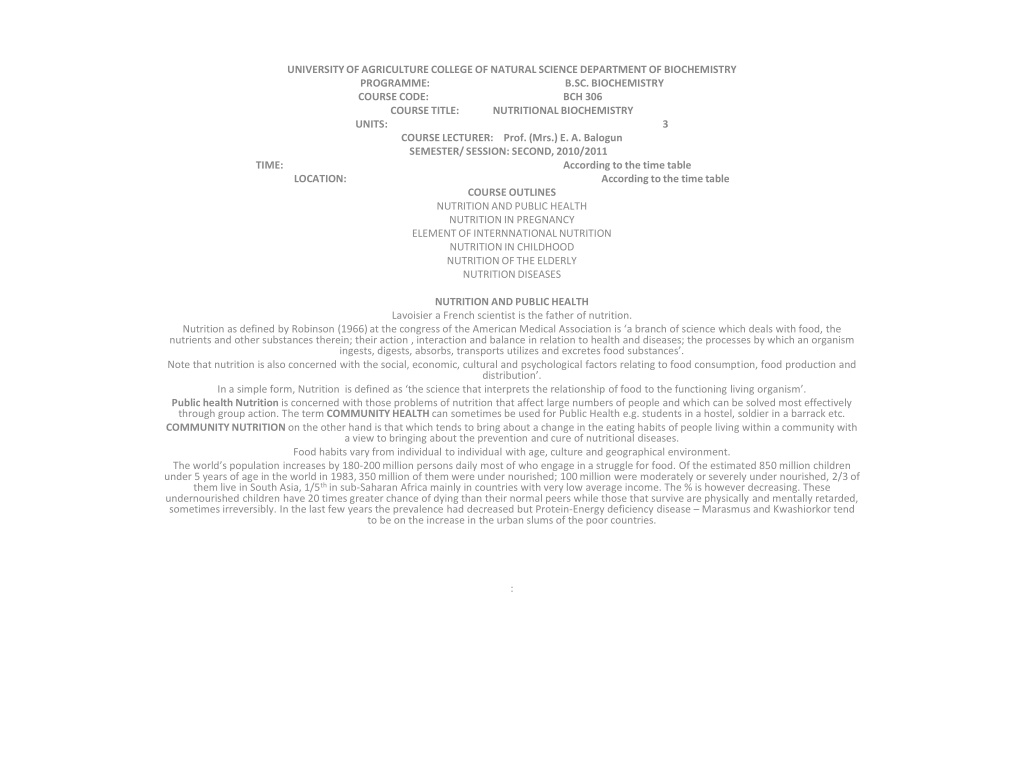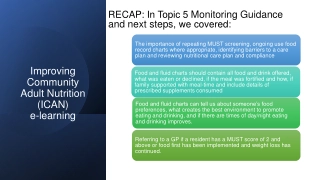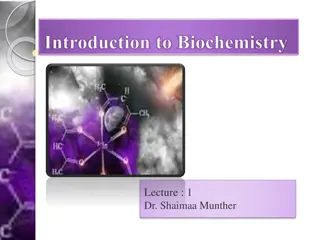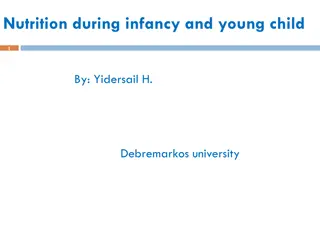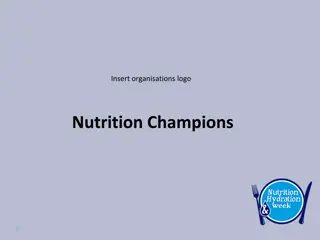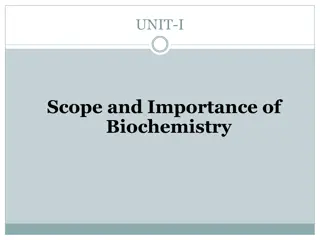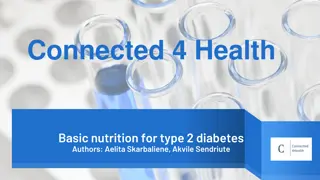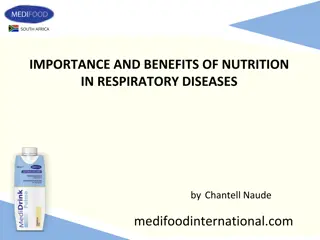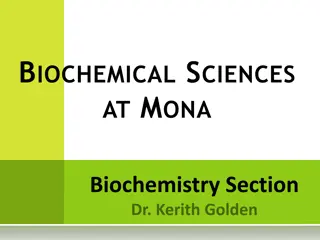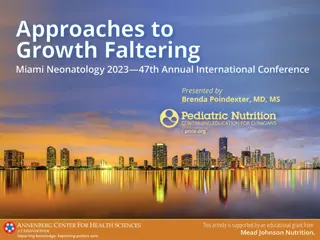Understanding Nutritional Biochemistry: A Comprehensive Overview of Nutrition and Public Health
Nutrition, as defined by Robinson, explores the relationship between food and the human body's functioning. This course delves into key topics such as nutrition in pregnancy, childhood, and the elderly, as well as nutrition-related diseases. It emphasizes the importance of public health nutrition in addressing widespread nutritional challenges and promoting overall well-being. The course also covers food group classifications and their nutritional value to understand balanced diets better and prevent deficiencies.
Download Presentation

Please find below an Image/Link to download the presentation.
The content on the website is provided AS IS for your information and personal use only. It may not be sold, licensed, or shared on other websites without obtaining consent from the author. Download presentation by click this link. If you encounter any issues during the download, it is possible that the publisher has removed the file from their server.
E N D
Presentation Transcript
UNIVERSITY OF AGRICULTURE COLLEGE OF NATURAL SCIENCE DEPARTMENT OF BIOCHEMISTRY PROGRAMME: COURSE CODE: COURSE TITLE: NUTRITIONAL BIOCHEMISTRY UNITS: COURSE LECTURER: Prof. (Mrs.) E. A. Balogun SEMESTER/ SESSION: SECOND, 2010/2011 B.SC. BIOCHEMISTRY BCH 306 3 TIME: According to the time table According to the time table LOCATION: COURSE OUTLINES NUTRITION AND PUBLIC HEALTH NUTRITION IN PREGNANCY ELEMENT OF INTERNNATIONAL NUTRITION NUTRITION IN CHILDHOOD NUTRITION OF THE ELDERLY NUTRITION DISEASES NUTRITION AND PUBLIC HEALTH Lavoisier a French scientist is the father of nutrition. Nutrition as defined by Robinson (1966) at the congress of the American Medical Association is a branch of science which deals with food, the nutrients and other substances therein; their action , interaction and balance in relation to health and diseases; the processes by which an organism ingests, digests, absorbs, transports utilizes and excretes food substances . Note that nutrition is also concerned with the social, economic, cultural and psychological factors relating to food consumption, food production and distribution . In a simple form, Nutrition is defined as the science that interprets the relationship of food to the functioning living organism . Public health Nutrition is concerned with those problems of nutrition that affect large numbers of people and which can be solved most effectively through group action. The term COMMUNITY HEALTHcan sometimes be used for Public Health e.g. students in a hostel, soldier in a barrack etc. COMMUNITY NUTRITION on the other hand is that which tends to bring about a change in the eating habits of people living within a community with a view to bringing about the prevention and cure of nutritional diseases. Food habits vary from individual to individual with age, culture and geographical environment. The world s population increases by 180-200 million persons daily most of who engage in a struggle for food. Of the estimated 850 million children under 5 years of age in the world in 1983, 350 million of them were under nourished; 100 million were moderately or severely under nourished, 2/3 of them live in South Asia, 1/5thin sub-Saharan Africa mainly in countries with very low average income. The % is however decreasing. These undernourished children have 20 times greater chance of dying than their normal peers while those that survive are physically and mentally retarded, sometimes irreversibly. In the last few years the prevalence had decreased but Protein-Energy deficiency disease Marasmus and Kwashiorkor tend to be on the increase in the urban slums of the poor countries. :
FOOD GROUPS The value of any food depends on its nutrient and non-nutrient constituents. They should be evaluated in terms of their total composition and not only for single nutrients for which they can be outstanding (e.g. beans- protein) therefore, one must consume all needed nutrients. Grouping of foods is based on the functions they are supposed to perform. By grouping together foods with similar nutrient content, it is possible to choose from a wide variety of alternatives if certain food becomes scarce or money is in short supply. The groupings also reflect availability of food, food patterns and local nutritional problems. The groups are (for tropical countries) (1) Milk group Made up of all dairy products fresh, skim, condensed, powdered milk, local & foreign cheese butter, yogurt and ice cream. Good for infants. Lactose intolerance people could take cheese, yogurt etc.Contain high Ca, Mg, riboflavin, cobalamin and high quality protein but is low in iron and vitamin C. (2) Meat group Meat, poultry, eggs, fish, snails, shrimps, crabs and other sea food, termites, legumes, seeds and nuts Although the nutritional contributions of each member of the group varies, they all provide valuable amounts of energy, proteins, iron and the B-complex vitamins. Since large amounts are consumed legumes are the most inportant source of protein in many African diets because they are cheap, palatable and keep fairly well. Usage of legumes, nuts, fish and poultry also reduce the intake of saturated fat that is abundant in meat. (3) Cereal Group This includes maize, guinea corn (sorghum) wheat, rice, barley, oats and teff. They contribute carbohydrates, B-complex vitamins, iron, magnesium and protein to the diets. They constitute the most important staple food for people all over the world. (4) STARCHY FRUIT/TUBER GROUP Examples are yams, coco-yams, cassava, potato, sweet potato, plantain and bread fruit. They are seasonal, contain large quality of starch but are perishable cannot be stored for long periods of time. Can supply about 385 KCal per, 100g of dry matter but with very low amounts of other nutrients. They are inferior to cereals because they consist of about 2/3rdwater and less proteins (about 2% compare to 8-10% in cereals) minerals and vitamins. (5) FRUIT/-VEGETABLE GROUP The term vegetable is used to include some fruits (tomatoes and pumpkins), leaves (spinach and cabbage), roots (carrots) stalks (celery) and flowers (cornflower). They provide water soluble vitamins, carotene (vitamin A) and minerals. Contribute to roughage in the diet in the form of cellulose. But have low protein content. Fruits-Mangoes, pawpaw, guava etc. Vegetables bitter leaves, water leaves, okra, onions, mushrooms etc. The cereal group and the fleshy fruit/tuber group constitute the largest portion of the typical African diet. They are often taken with soup (mixture of meat, fruit, vegetable oil etc which supply proteins, vitamins and minerals of high quality. (6) EMPTY CALORIE FOOD E.g. Alcohol, alcoholic beverages, carbonated drinks. THE NUTRIENTS These are the constituents of food which must be supplied to the body in suitable amount, they are carbohydrates, fats & oils, proteins, vitamins, minerals and water. The first 3 are referred to as macro nutrients. All of them can be divided into 3 groups. Energy giving nutrients proteins, fats & oils, & carbohydrate Body-building nutrients proteins, fats, carbohydrate, minerals & water Body processes regulatory substances Under laboratory condition the essentiality of a nutrient can be established when A deficiency state occurs on a diet considered adequate in all respects except the nutrient under study The deficiency state correlation with sub-normal levels of the nutrient in the blood or certain tissues. There is significant growth response in growing animals in repeated demonstration after supplements of the nutrient under study. When consumed in correct amount and proportion one is placed in the best position to maintain the highest level of health. A deficiency, an excess or an unbalance in the intake of these nutrients results in an aberration in health. CARBOHYDRATES They are classified into monosaccharide, disaccharides and polysaccharides. Monosaccharide simplest form of carbohydrate e.g. glucose fructose galactose etc. Disaccharides maltose, lactose sucrose. Polysaccharides the most complex therefore, must undergo digestion before they can be absorbed into the blood and utilized in the body e.g. starches, cellulose &
FUNCTION: Source of metabolic energy. If carbohydrate intake is sufficient in the diet proteins may not be used to produce energy. They are the starting materials for the synthesis of several compounds in the body mucopolysaccharide, glycoprotein, etc. Cellulose, hemicelluloses & pectin provide bulk in the intestines and in the excretion of waste products. Minimum daily carbohydrate for human adult is 100g obtain from yam, cassava, coco-yam, sweet and Irish potatoes honey, jams, vegetables wheat. Clinical Application Normally there are no specific disease caused by the deficiency or excess consumption of carbohydrate but there are some related to refined carbohydrate intakes which are: Dental caries resulting for excessive consumption of sugar empty calories foods Colon cancer Obesity and/overweight problems Diabetes mellitus Elevated serum TGs Cardiovascular diseases. LIPIDS Lipids or fats are water insoluble but soluble in ether or other fat solvents such as chloroform. Classified into simple lipid, compound and derived lipid. SIMPLE LIPIDS Also referred to as dietary lipid consist only of triglycerides it is the most important in human nutrition. Compound lipids phospholipids, lipoproteins Derived lipids sterols, Complex lipids - TRIGLYCERIDES Fatty acid of glycerol. Fatty acids short chained < 6C, medium 6 12C, long 12 18C or extra long chained 20 or more. Long chained Fatty acid occurs in animal fats and most vegetable oils, the extra long chained are found in fishes. They can be saturated or unsaturated depending on their degree of H saturation. Unsaturated FA contain double bonds. FA containing 12C and those that are unsaturated are liquid at room temperature. While saturated FA containing 14C atoms are solid at room temperature e.g. Oleic, palmitic and stearic acid. Visible fats are those seen in butter or vegetable oils while invisible fats are those dispersed within food e.g. hidden fat in meat marbling. PUFA Poly-unsaturated fatty acids that cannot be synthesised in the human body and must be supplied in the diet they are also called Essential fatty acids linoleic, linolenic and arachidonic acid. Deficiency of them may cause eczematous dermatitia, sparse hair growth, poor wound healing. FUNCTION: To provide energy and heat. Contain 9 KCal/g compared to carbohydrate and protein which provide 4 KCal/g each. For transport of the fat soluble vitamins. Essential for the formation of nerve sheaths. Act as lubricants in the intestine. Add flavour to food. Required for the production and secretion of bile. Serve as packing materials in the body to prevent heat loss and to support the kidneys, eyes, and other internal organs. Clinical Problems Condition requiring fat metabolism or reductions are malabsorption syndromes, cystic fibrosis), fatty liver, diabetes mellitus, hyperlipidemia and obesity: such patients should select food low in fats. Those that require the addition of fat to the diet in e.g. underweight conditions. Dietary fat is a risk factor in coronary heart disease, colon and breast cancers. PROTEIN: The most abundant compounds in the body exceeded only by water is protein. About 18-20% of the body weights. 1/3 in the muscle, 1/5 in the bones and cartilage, 1/10th in the skin the remaining ones are in other tissues and body fluids except urine and bile. During digestion, protein is broken down into 23 different amino acids - 8 essential for adults while in infants and children these + histidine are required. Valine, threonine, tryptophan, histidine, isoleucine, leucine, lysine, methionine and phenylalanine (VATT HILL MP). Animal foods contain greater amounts of essential amino acids than plant food. The value or quality of a protein is determined by its amino acid composition. Biological value of a protein is an indication of the ability of that protein to support growth and repair of tissue cells in childhood and in later life. Proteins of animal origin have higher B.V. Plant foods contain insufficient amount of one or more of the following amino acids lysine, threonine, tryptophan and methionie. The correction of amino acid deficiencies in plant proteins is made through a process called Protein Complementarity. In this case two different protein of different essential amino acids which are low in one food are complemented in the other food eaten.
FUNCTIONS For growth from birth till death for building and for maintenance of body tissues. For synthesis of enzymes, hormones, anti bodies haemoglobin and anti-toxins They contribute to blood osmotic pressure. For the production of energy especially when insufficient energy is provided in the diet. Individuals who consume no animal foods are known as vegans. Vegetarians who include eggs and dairy products are called lacto-ovo-vegetarians while those who include only dairy products are the lacto-vegetarians. Both groups are capable of maintaining perfect health. Children on such diet may have protein energy deficiencies. They must therefor take Vitamin B12as supplement to prevent pernicious anaemia. Requirement: - Male = 56 g/day; Female = 46 g/day; Infants = 2.2 g/Kg body weight; 0 6 months and 2.0 g/Kg. Plant protiens provide more than 50% of human protien supply. Soures: - meat, fish, eggs, milk, cheese, snail, beans, groundnut, melon, seeds, locust beans, cereals (wheat, rice etc). Deficiency of proteins results in such diseases as kwashorkor, marasmus and the intermediate marasmus kwashorkor. VITAMINS They are organic compounds that are required in very small quantities to perform specific cellular functions and thus promote growth, reproduction and maintenance of life. They cannot be synthesized in sufficient amounts by the human body and has to rely on exogenous sources for its supply therefore essential but vitamin D, K and Niacin can be made within the human body. They are fat soluble vitamin A D E K and water soluble one B- Complex vitamin thiamine, riboflavin, niacin, pyridoxine, biotin, pantothenic acid, folic acid, cyanocobalamin and ascorbic acid (vitamin C). Primary deficiency is caused by consuming a diet that is inadequate in the vitamin concerned while in secondary deficiency the recommended allowance may be consumed but because of disease, medication or physiological state such as pregnancy, lactation and growth the actual requirement is increased. Insufficient intakes lead to deficiency symptom e.g. Vitamin A night blindness, Xerophthalmia, Vitamin D rickets Thamin Beriberi, Niacin Pellagia etc. Vitamin C Scurvy. MINERALS They are inorganic crystalline and homogenous chemicals which perform unique roles in the body. They control water balance; Regulate acid base balance, Are cofactors of enzymes, homones etc, Structural components of body tissues e.g. Ca, P Are necessary for nerve cell and muscle function. Classified based on their quantity in the body as macro nutrients (Ca, Cl, K, P, Mg, Na) , micro nutrient Co, Cu, Fl2, I2, Fe etc. Man requires 14 minerals for optimum growth. WATER Is found in every cell of the body and is the largest single component of the human body. Total body varies from 78% at birth to 60% in adult male 50% in adult female. It is distributed as ECF and ICF. ICF water , ECF plasma, intersticial (lymph) and trans-cellular fluid Water balance:- Water intake from (water, food, drinks) metabolic H20 from oxidation of carbohydrate, fats & proteins. H2O loss through- faeces, urine, skin and breadth (expiration). Solid foods contribute about 25-50% of water needed by the body each day e.g. l g of proteins, carbohydrate, and fats provides 0.41g, 0. 61g, 1.07g of water and 1 kg of body fat = 1 L of water. Water intake is determined by habit and customs, and environment e.g. hot temperature more water is taken. Clinical application: - Generally a 2% loss of body water due to dehydration produce thirst. Change in the volume of total body water can be as a result of failure of intake or abnormal loss. Dehydration is due to deficient of either water or electrolytes or both. If due to loss of electrolytes in excess of water, the result is hypotonic dehydration e.g. diarrhoea patients treated without including electrolytes. Loss of water in excess of electrolytes leads to hypertonic dehydration. Loss of 4% of body water causes oliguria tachycardia (rapid heartbeat) and postural hypertension. Infants are more sensitive to electrolyte and fluid imbalance and prone to hypertonic dehydration because of greater evaporation losses and then immature kidney and inability to concentrate urine. If dehydration result from blood loss 3 4 times the volume of blood will be required to maintain cardiac output if replaced by electrolyte solution. NB: Decreased thirst is a sign of improvement in an alert patient. Function
glycogen. As a solvent for for digestive processes, carries nutrient to the tissues and waste product away. As a regulator controls body temperature. Facilitates conversion of food into tissue and energy Serves as lubricants in the GIT, joints, eyes etc. Structural component of the body, blood, lymph As an end product of fat, carbohydrate, protein catabolism(Kreb s cycle). FOOD ENERGY Food energy is the first nutritional priority of the human body system. It is required for all metabolic processes, contraction of the heart, and movement of diaphragm in breathing. Physical activities - daily work, exercise, maintenance of body temperature; biosynthesis, maintenance and repair of new and old tissues. Energy is derived from carbohydrate, proteins, fat and oil - 4 KCal, 9 and 4 KCal/g. A typical human diet should provide 50-56% of its Energy from carbohydrate 30 35% of its energy from fats and oil 12 18% of its energy from proteins Cellulose and water do not provide energy. BASAL METABOLIC RATE: It s the energy required for the basic maintenance of the cells of the body and body temperature. It is influenced by such factors as; Age, Sex (women BMR lower than man) Weight (size and shape) Rate of growth, Endocrine activity -hyperthyoidism increases it while hypothyoidism decreases it. Sleep (it is 10% lower than waking). Body temperature: 1oF rise in body temperature increases BMR by 7% State of Nutrition Physiological state e.g. last trimester of pregnancy it is increases by 15 - 25%. For an average individual ranges between 1300 1700 KCal/day. FAO declaration: Individuals of the same size, living in the same environment and with the same mode of life have a similar energy requirement whatsoever the ethnic origin. BIOCHEMICAL ASPECTS OF NUTRITION AND ENERGY REQUIREMENT Nutrition is the science that deals with food requirements and utilization. It also deals with the elimination of waste products resulting from ingested foods. Dietetics deals with the design of diets to suit different conditions. It involves the interpretation and application of the principles of nutrition in health and disease. Food can be defined as anything solid or liquid possessing a chemical composition which enables it when swallowed to do one or more of the following: To provide the body with the materials from which it can produce work, heat and other forms of energy. Provide materials for growth, maintenance repair and reproduction. Supply substances which normally regulate the production of energy or process of growth repair and reproduction e.g. homones and enzymes. This definition of food encompasses all recorganised foodstuffs from which the nutrients carbohydrates, fats, proteins, vitamins and minerals are derived as well as other groups of substances such as alcohols, and some plant production like organic acids and hemicelluloses compounds. The energy requirements of man are met by 3 classes of organic foodstuffs: carbohydrate, proteins and fats. The metabolism of carbohydrate supplies more than half of the energy required for the day. For example, a sedentary woman requires 2000 Kcal per day. Her carbohydrate intake must be designed to contribute more than half of this requirement, otherwise fat and proteins may be called upon to supply it.. This impairs other specifically attributed functions of proteins, viz: repair and growth. The main conversion factor of the energy values of food may be summarized as follow Protein 4.1 Carbohydrate4.1 Fat 9.3 Energy expenditure may be classified as follows: Based metabolism
When a subject is at complete rest and no physical work is being carried out, energy is required for the activity of the internal organs and to maintain body temperature. This is referred to as basal or resting metabolism and it is estimated by measuring the basal metabolic rate (BMR). It is fairly constant for a given individual and is influenced by age, sex, body sex, environmental temperature, barometric pressure and such physiological state as lactation and pregnancy. Specific Dynamic Action (SDA): Some food terms usually generate heat when consumed i.e. they are calorigenic. The effect of such food substances is raising the metabolic rate above the basal rate is referred to as Specific Dynamic Action. It has been shown that metabolism might increase by as much as 30% during protein ingestion. The heat produced by the SDA of protein contributes to the maintenance of body temperature. Muscular Activity: This is the most important variable under normal condition. It depends on the type of work the individual engages in e.g. Energy requirement per day (in KCal) Adult Sedentary Moderately Active Strongly Active During lactation During Pregnancy Children: 16-20 years 10-12 years 4-6years Under 1 years If energy provision is not sufficient to meet the demand, the body tissues will be called upon. In prolonged starvation, the adequate tissue is depleted and ketosis results. The body will become emanciated and this leads to a condition known as marasmus. When a child is overfed with carbohydrate, with little or no protein, the needed protein will be drawn for the blood. This results in a reduction in osmotic pressure and consequently oedema. Proteins contribute between 10 and 15 percent of the total energy value of most balanced diets. They are very important because every cell in the body is partly composed of protein which as constantly being broken down and replaced. They also contain nitrogen and sulphur which are not found in other food compounds such as carbohydrates and lipids. Furthermore, while fats can be synthesized from dietary carbohydrate and carbohydrates from amino acids in proteins, the proteins required by the body are usually derived for dietary sources. Therefore the function of dietary proteins can be summarized as follows: Supply of energy As constituents of tissue in the form of enzyme and hormones which require chemical processes with the cell. As blood proteins which aid in controlling the distribution of fluid in the body and in providing antibodies (i.e. plasma gammaglobins). To combat infection as well as haemoglobin in erythrocyte which serve to transport oxygen from lungs to tissues. Growth and tissue repair Quality of food protein: Food proteins vary in the efficiency of their utilization for the synthesis of tissues protein. The efficiency of dietary protein is usually measured by any of the following: Protein Efficiency Ratio (PER) Biological Value (BV) Net Protein Utilization (NPU) PER: is the amount of body weight gained per gram of protein consumed. BV: of a protein is the amount of protein incorporated into the body tissue. It is calculated as N Retained X 100 N Absorbed NPU: is the amount of dietary protein that has actually become part of the body. Calculated as N Retained X 100 N intake Male Female 2,400 3,000 4,500 2,000 2,400 3,000 3,000 2,400 Female 2,400 2,000 1,600 Male 3,180 2,500 1,600 110 110
BV makes no allowance for losses of N during digestion. The most important single fact that influences the quality of a protein is the quantity of the essential amino acid in the protein. There are those that cannot be synthesised in adequate amount to meet body requirement. They have to be supplied in the diet for adult human. They are Valine, Isoleucine Leucine, Methionine, Phenylalanine, Tryptophan and Lycine. Histidine is added for infant. Histidine and Arginine are added for Rats. Consequences of protein deficiency Retarded growth in children and low of body in adult Delayed wound healing in adults and children. Impaired haemoglobin synthesis resulting in anaemia In extreme cases, excess amount of fat may accumulate in the liver resulting fibrosis of the liver Inadequate synthesis of plasma protein leading to oedema Resistance to infection because of lower antibody production Certain hormones or enzymes may be absent or produced in little quantities leading to impaired function of the tissues.
